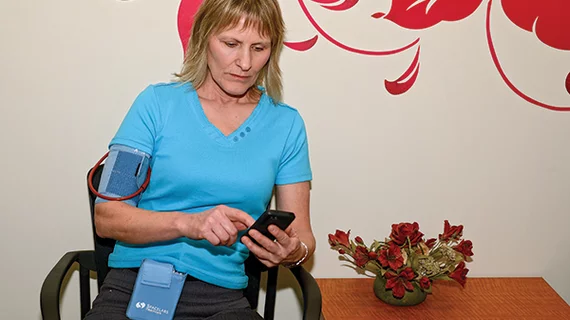The benefits of a telemonitoring hypertension intervention waned after patients returned to a normal care strategy, according to a study published Sept. 7 in JAMA Network Open.
Karen L. Margolis, MD, MPH, and colleagues studied how well 450 participants in a hypertension trial maintained their blood pressure (BP) improvements after a 12-month intervention ended. Participants were randomized to either usual care or a home-based telemonitoring approach in which they were asked to transmit six BP measurements per week and engage in regular telephone coaching sessions with pharmacists.
Compared to the usual care group, those in the pharmacist-led intervention achieved:
- An additional 10.7 mm Hg reduction in systolic BP (SBP) from baseline to six months.
- An additional 9.7 mm Hg reduction in SBP at 12 months.
- An additional 6.6 mm Hg reduction in SBP at 18 months.
- An additional 2.5 mm Hg reduction in SBP at 54 months, which was no longer statistically significant.
Differences in diastolic BP (DBP) followed a similar trajectory, starting out with a gap of 6 mm Hg, which gradually shrunk over time until the relative reductions weren’t statistically significant.
For the intensive treatment group, blood pressures rose an average of 4.9/2.4 mm Hg from 12 months—the end of the intervention—to 54 months of follow-up.
Notably, though, both groups still achieved clinically relevant reductions in both SBP and DBP from baseline to 54 months. The mean baseline measurements were about 148/85 for both groups but improved to 130.6/77.5 in the intervention group and 132.6/79.1 in the usual care cohort.
“Members of our research group previously reported that the two significant mediators of the intervention effect were increased medication treatment intensity and increased home BP monitoring, which together accounted for about 5 mm Hg of the difference in SBP at 6 months,” Margolis and colleagues reported. “No differences in these mediating factors were present at 54 months owing to a decrease in the proportion of patients doing home BP monitoring in the (telemonitoring intervention) group and a modest increase in the antihypertensive treatment intensity in the (usual care) group.”
According to data in the electronic health record, the benefit of the telemonitoring approach appeared to extend to 24 months of follow-up, or a year after the intervention ended. However, blood pressure differences between the two groups started to shrink after that.
“BP reductions of this magnitude and duration have the potential to result in clinically important effects on cardiovascular events, even if BP was not different at 54 months,” the authors wrote. “Nevertheless, long-term maintenance of BP control is likely to require continued monitoring and resumption of the intervention if BP increases. More work is needed to determine the content, intensity, and duration of reinforcement that are needed for maintaining intervention benefits over a longer period.”

